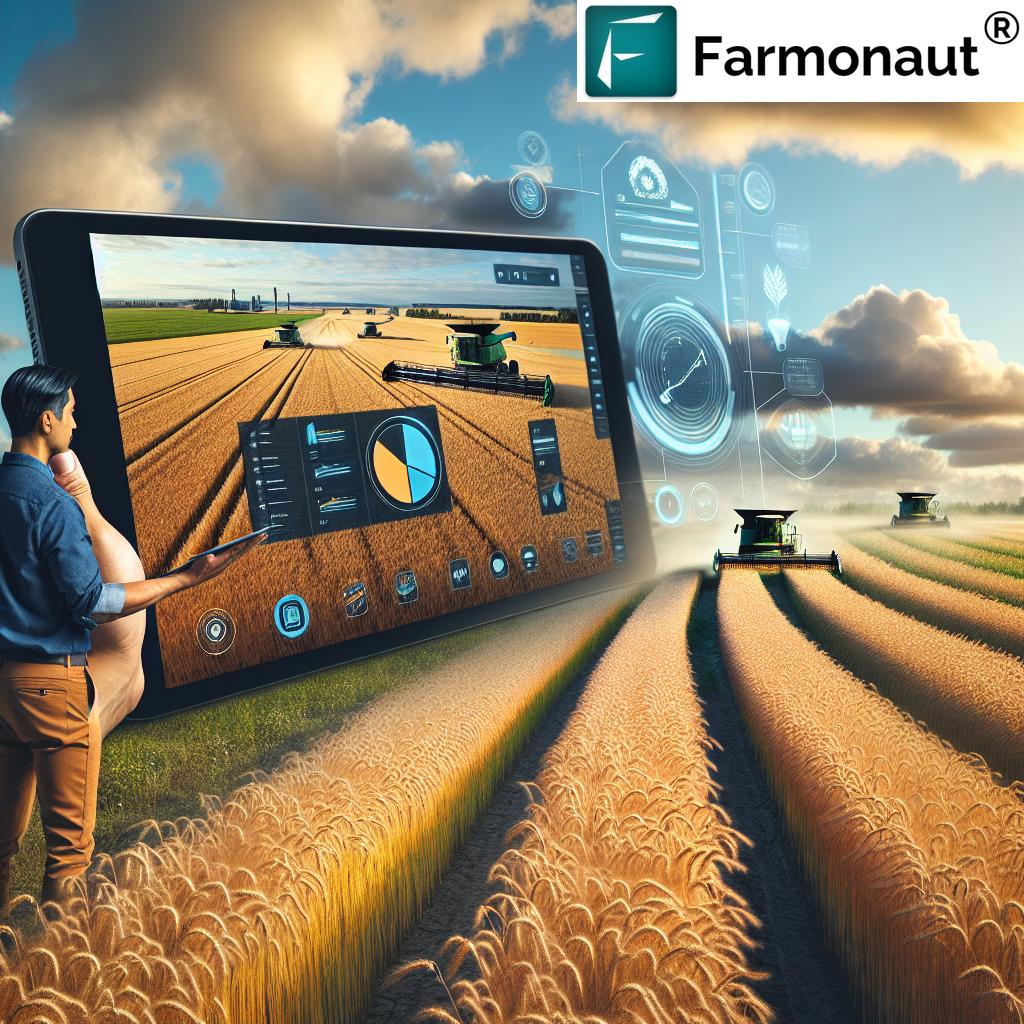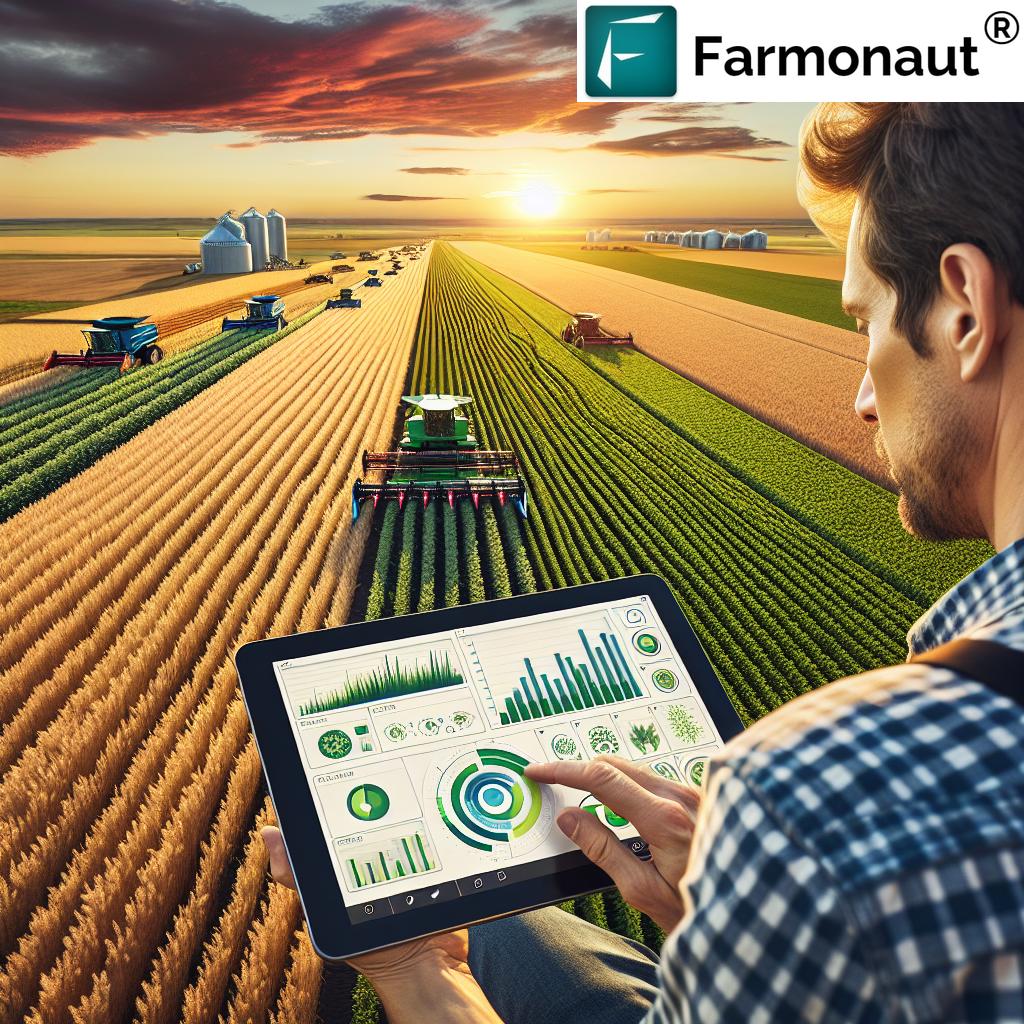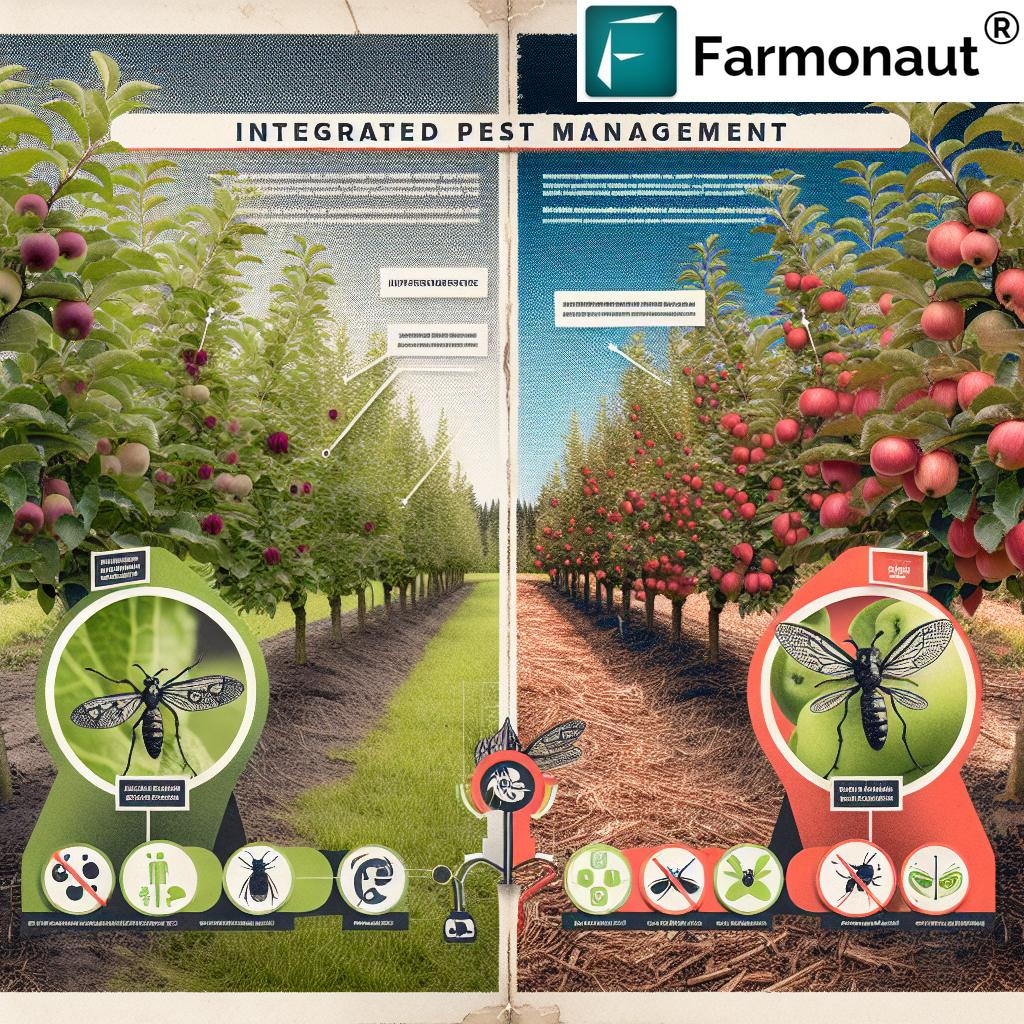Revolutionizing Digital Agriculture: How Precision Farming Software Is Transforming Crop Management in the United States and Canada
“Precision agriculture software has increased crop yields by up to 20% in some U.S. and Canadian farms.”
In the ever-evolving landscape of agriculture, we are witnessing a revolutionary transformation driven by precision farming software and digital agriculture solutions. As we delve into the world of advanced farm management platforms, we’ll explore how these cutting-edge technologies are reshaping crop management practices across the United States and Canada. From leveraging satellite imagery to harnessing the power of GIS technology, these innovations are not just enhancing crop health analysis but are fundamentally boosting farm productivity in ways we couldn’t have imagined a decade ago.
At the forefront of this agricultural revolution is Farmonaut, a pioneering company that’s making waves with its innovative platform. By integrating satellite-based farm management solutions, Farmonaut is democratizing access to precision agriculture, making it more affordable and accessible to farmers worldwide. But before we dive deeper into Farmonaut’s offerings, let’s explore the broader landscape of digital agriculture and how it’s transforming the farming industry.
The Rise of Precision Agriculture Software
Precision agriculture software has emerged as a game-changer in the farming industry. These sophisticated tools allow farmers to make data-driven decisions, optimizing every aspect of their operations. Here’s how these software solutions are revolutionizing agriculture:
- Data-Driven Decision Making: By collecting and analyzing vast amounts of data, precision agriculture software enables farmers to make informed decisions about planting, irrigation, fertilization, and harvesting.
- Resource Optimization: These tools help farmers use resources more efficiently, reducing waste and increasing profitability.
- Increased Yields: With more precise management, farmers can significantly increase their crop yields while minimizing environmental impact.
- Climate Adaptation: Precision agriculture software helps farmers adapt to changing climate conditions by providing real-time data and predictive analytics.
One of the key players in this space is Farmonaut, offering an advanced platform that integrates satellite imagery, artificial intelligence, and blockchain technology to provide comprehensive farm management solutions. You can explore Farmonaut’s web application here.

Harnessing Satellite Imagery for Agriculture
One of the most significant advancements in digital agriculture has been the integration of satellite imagery. This technology provides farmers with a bird’s-eye view of their fields, offering invaluable insights into crop health, soil conditions, and more. Here’s how satellite imagery is transforming agriculture:
- Crop Health Monitoring: Multispectral satellite images can detect variations in crop health, allowing for early intervention in case of disease or pest infestations.
- Soil Moisture Analysis: Satellite data can provide information on soil moisture levels, helping farmers optimize irrigation practices.
- Yield Prediction: By analyzing historical and real-time satellite data, farmers can make more accurate yield predictions, aiding in better planning and resource allocation.
Farmonaut’s platform leverages satellite imagery to provide real-time crop health monitoring, enabling farmers to make timely decisions that can significantly impact their yields. For developers interested in integrating these capabilities, Farmonaut offers an API that can be explored here.
GIS Technology in Agriculture
Geographic Information Systems (GIS) have become an integral part of precision agriculture. These systems allow farmers to visualize, analyze, and interpret data to understand relationships, patterns, and trends. Here’s how GIS is being used in agriculture:
- Field Mapping: GIS helps create detailed maps of fields, including information on soil types, topography, and crop varieties.
- Precision Planting: By integrating GIS data with planting equipment, farmers can optimize seed placement based on soil conditions and other factors.
- Variable Rate Application: GIS enables variable rate application of fertilizers and pesticides, ensuring that inputs are applied only where and when they’re needed.
Farmonaut’s platform incorporates GIS technology to provide farmers with detailed field-level insights, enabling more precise and efficient farm management practices.
“Satellite-based crop health analysis can detect plant stress up to 2 weeks earlier than visual inspection.”
Agricultural Data Visualization
The ability to visualize agricultural data in meaningful ways is crucial for effective decision-making. Advanced data visualization tools are helping farmers and agronomists to:
- Identify Patterns: Visual representations of data make it easier to spot trends and patterns that might not be apparent in raw data.
- Compare Performance: Farmers can easily compare the performance of different fields or crops over time.
- Communicate Insights: Visual data makes it easier to share insights with stakeholders, from farm workers to investors.
Farmonaut’s platform offers robust data visualization tools, allowing farmers to gain actionable insights from complex datasets. You can experience these features firsthand by downloading the Farmonaut app for Android or iOS.

Variable Rate Fertilizer Application
Variable rate technology (VRT) is revolutionizing how farmers apply fertilizers and other inputs. This precision agriculture technique allows for the application of different amounts of fertilizer in different areas of a field, based on specific needs. Here’s why it’s important:
- Resource Efficiency: VRT reduces fertilizer waste by applying only what’s needed where it’s needed.
- Environmental Protection: By preventing over-application, VRT helps reduce nutrient runoff and environmental impact.
- Cost Savings: More efficient use of fertilizers can lead to significant cost savings for farmers.
Farmonaut’s platform includes tools for creating variable rate prescriptions, helping farmers optimize their fertilizer use and improve their bottom line.
Smart Irrigation Systems
Water management is a critical aspect of modern agriculture, especially in regions facing water scarcity. Smart irrigation systems are helping farmers use water more efficiently:
- Soil Moisture Sensors: These devices provide real-time data on soil moisture levels, allowing for precise irrigation scheduling.
- Weather-Based Controllers: By integrating weather forecast data, these systems can adjust irrigation schedules to avoid watering before or during rainfall.
- Drip Irrigation: This method delivers water directly to plant roots, minimizing evaporation and runoff.
Farmonaut’s platform integrates with various smart irrigation systems, providing farmers with comprehensive water management solutions that can significantly reduce water usage while improving crop yields.
AI in Pest and Disease Detection
Artificial Intelligence (AI) is playing an increasingly important role in pest and disease detection in crops. Here’s how AI is revolutionizing this aspect of agriculture:
- Early Detection: AI algorithms can analyze satellite and drone imagery to detect signs of pest infestations or diseases before they become visible to the naked eye.
- Precise Identification: By comparing images against vast databases, AI can accurately identify specific pests or diseases, allowing for targeted treatment.
- Predictive Analytics: AI models can predict potential outbreaks based on historical data and current conditions, enabling proactive measures.
Farmonaut’s Jeevn AI Advisory System leverages AI technology to provide farmers with real-time insights and expert crop management strategies, including pest and disease detection and management.
Adapting to Climate Challenges
Climate change poses significant challenges to agriculture, but digital farming solutions are helping farmers adapt:
- Climate Modeling: Advanced software can model future climate scenarios, helping farmers plan for long-term changes.
- Crop Selection: Data-driven tools can help farmers choose crops and varieties best suited to changing climate conditions.
- Risk Management: Precision agriculture software can help farmers mitigate climate-related risks through better planning and resource management.
Farmonaut’s platform includes features for climate adaptation, helping farmers make informed decisions in the face of changing environmental conditions.
Comparison: Traditional vs. Advanced Precision Agriculture
| Features | Traditional Farm Management | Advanced Precision Agriculture Software (e.g., Farmonaut) |
|---|---|---|
| Data Sources | Manual observations, basic weather data | Satellite imagery, IoT sensors, AI analysis, comprehensive weather data |
| Crop Health Analysis | Visual inspection, limited soil testing | Real-time satellite-based health monitoring, AI-driven analysis |
| Fertilizer Application | Uniform application across fields | Variable rate application based on precise field data |
| Irrigation Management | Scheduled watering, manual adjustments | Smart irrigation systems, soil moisture sensors, weather-based adjustments |
| Pest and Disease Detection | Regular field scouting, reactive measures | AI-powered early detection, predictive analytics |
| Climate Adaptation Tools | Limited long-term planning based on historical trends | Advanced climate modeling, data-driven crop selection, risk management tools |
| Decision Support | Experience-based decisions, limited data analysis | AI-driven insights, comprehensive data visualization, real-time advisory systems |
The Future of Digital Agriculture
As we look to the future, the potential for digital agriculture continues to expand. Here are some trends we’re watching:
- Internet of Things (IoT) in Agriculture: The proliferation of IoT devices will provide even more granular data for decision-making.
- Blockchain in Supply Chains: Blockchain technology will enhance traceability and transparency in agricultural supply chains.
- Autonomous Farm Equipment: Self-driving tractors and drones will further automate farm operations.
- Vertical Farming: Digital solutions will play a crucial role in optimizing indoor and urban farming operations.
Farmonaut is at the forefront of these trends, continually innovating to provide farmers with the most advanced and effective digital agriculture solutions.
Farmonaut: Leading the Digital Agriculture Revolution
As we’ve explored throughout this article, Farmonaut is at the forefront of the digital agriculture revolution. By combining satellite technology, AI, and blockchain, Farmonaut offers a comprehensive suite of tools that address the diverse needs of modern agriculture. Here’s a recap of what makes Farmonaut stand out:
- Satellite-Based Crop Health Monitoring: Real-time insights into vegetation health, soil moisture, and other critical metrics.
- Jeevn AI Advisory System: Personalized farm advisory tool delivering real-time insights and expert crop management strategies.
- Blockchain-Based Traceability: Ensuring transparency and security in agricultural supply chains.
- Fleet and Resource Management: Tools for optimizing agricultural machinery usage and logistics.
- Carbon Footprinting: Helping agribusinesses monitor and reduce their environmental impact.
Farmonaut’s platform is designed to be accessible and affordable, making precision agriculture available to farmers of all scales. Whether you’re managing a small family farm or overseeing large-scale agricultural operations, Farmonaut has solutions to meet your needs.
Ready to revolutionize your farming practices? Explore Farmonaut’s offerings:
Farmonaut Subscriptions
Frequently Asked Questions
Q: What is precision agriculture software?
A: Precision agriculture software is a set of digital tools and technologies that help farmers manage their fields and crops more efficiently. These tools use data from various sources such as satellites, sensors, and weather stations to provide insights that enable farmers to make more informed decisions about planting, fertilizing, irrigating, and harvesting their crops.
Q: How does satellite imagery benefit farmers?
A: Satellite imagery provides farmers with a bird’s-eye view of their fields, allowing them to monitor crop health, detect issues early, and make data-driven decisions. It can show variations in crop growth, soil moisture, and other factors across large areas, helping farmers identify problem areas and optimize their management practices.
Q: What is variable rate fertilizer application?
A: Variable rate fertilizer application is a precision agriculture technique that allows farmers to apply different amounts of fertilizer to different areas of a field based on specific needs. This approach optimizes fertilizer use, reduces waste, and can lead to better crop yields and environmental outcomes.
Q: How does AI contribute to pest and disease detection in crops?
A: AI algorithms can analyze satellite and drone imagery to detect signs of pest infestations or diseases before they become visible to the naked eye. These systems can also predict potential outbreaks based on historical data and current conditions, allowing farmers to take proactive measures.
Q: What makes Farmonaut different from other precision agriculture platforms?
A: Farmonaut stands out by offering a comprehensive suite of tools that integrate satellite technology, AI, and blockchain. It provides affordable access to precision agriculture for farmers of all scales, with features like real-time crop health monitoring, AI-driven advisory systems, and blockchain-based traceability solutions.
In conclusion, the digital agriculture revolution is transforming crop management in the United States, Canada, and beyond. Precision farming software, like that offered by Farmonaut, is empowering farmers to make data-driven decisions, optimize resource use, and adapt to climate challenges. As these technologies continue to evolve, we can expect to see even greater improvements in agricultural productivity, sustainability, and profitability. The future of farming is digital, and it’s happening right now.
















